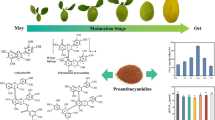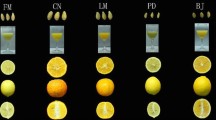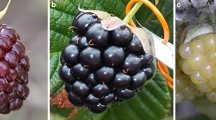Abstract
Juçara (Euterpe edulis M.) fruits are an interesting source of phenolic compounds, mainly anthocyanins, making them valuable to the food and pharmaceutical industries. Juçara fruits were harvested along the on-tree ripening process between March and June as practiced in Paraná state, Brazil and examined for their total anthocyanin content (TAC), total phenolic content (TPC), total phenolic acid (TPA) and total antioxidant capacity (TAA). Overall, TAC increased (91.52–236.19 mg cyanidin-3-glucoside equivalent/100 g dm) whereas TPC (81.69–49.09 mg GAE/g dm) and TPA (44.27–30.95 mg/100 g dm) decreased during ripening of juçara fruits. Use of tandem mass spectrometry allowed the identification of cyanidin-3,5-diglucoside, peonidin-3-glucoside and peonidin-3-rutinoside for the first time in juçara fruits. The analysis of the phenolic acids by HPLC-MS/MS indicated the presence of gallic, protocatechuic, p-hydroxybenzoic, vanillic, chlorogenic, caffeic, syringic, p-coumaric, sinapinic and ferulic acids. The high antioxidant capacity using DPPH radical scavenging capacity (655.89–745.32 μmol TE/g dm) and ORAC assays (1088.10–2071.55 μmol TE/g dm) showed that juçara fruits have potential as a source of novel natural antioxidants for disease prevention and health promotion, and also as natural food additives for developing new functional food products.

Similar content being viewed by others
References
Lorenzi H (2006) Frutas brasileiras e exóticas cultivadas (de consumo in natura). Instituto Plantarum de Estudos da Flora, São Paulo
Paredes-López O, Cervantes-Ceja ML, Vigna-Pérez M, Hernández-Pérez T (2010) Berries: improving human health and healthy aging, and promoting quality life—a review. Plant Foods Hum Nutr 65:299–308
Yao LH, Jiang YM, Shi J, Tomas-Barberan T, Datta N, Singanusong R, Chen SS (2004) Flavonoids in food and their health benefits. Plant Foods Hum Nutr 59:113–122
Clifford MN (2000) Review: anthocyanins—nature, occurrence and dietary burden. J Sci Food Agric 80:1063–1072
Brito ES, Araújo MCP, Alvez RE, Carkeet C, Clevidence BA, Novotny JA (2007) Anthocyanins present in selected tropical fruits: acerola, jambolão, jussara, and guajiru. J Agric Food Chem 55:9389–9394
Rufino MSM, Alves RE, Fernandes FAN, Brito ES (2011) Free radical scavenging behavior of ten exotic tropical fruits extracts. Food Res Int 44:2072–2075
Borges GSC, Vieira FGK, Copetti C, Gonzaga LV, Zambiazi RC, Filho JM, Fett R (2011) Chemical characterization, bioactive compounds, and antioxidant capacity of jussara (Euterpe edulis) fruit from Atlantic Forest in Southern Brazil. Food Res Int 44:2128–2133
Inácio MRC, Lima KMG, Lopes VG, Pessoa JDC, Teixeira GHA (2013) Total anthocyanin content determination in intact açaí (Euterpe oleracea Mart.) and palmiteiro-juçara (Euterpe edulis Mart.) fruit using near infrared spectroscopy (NIR) and multivariate calibration. Food Chem 136:1160–1164
AOAC (2003) Official methods of analysis, 17th edn. Association of Official Analytical Chemists, Washington DC
Mattila P, Hellström J, Törrönen R (2006) Phenolic acids in berries, fruits and beverages. J Agric Food Chem 54:7193–7199
Lee J, Durst RW, Wrolstad RE (2005) Determination of total monomeric anthocyanin pigment content of fruit juices, beverages, natural colorants, and wines by the pH differential method: collaborative study. J AOAC Int 88:1269–1278
Li W, Hydamaka AW, Lowry L, Beta T (2009) Comparison of antioxidant capacity and phenolic compounds of berries, chokecherry and seabuckthorn. Cent Eur J Biol 4:499–506
Brand-Williams W, Cuvelier ME, Berset C (1995) Use of a free radical method to evaluate antioxidant activity. LWT Food Sci Technol 28:25–30
Huang D, Ou B, Hampsch-Woodill M, Flanagan JA, Prior RL (2002) High-throughput assay for oxygen radical absorbance capacity (ORAC) using a multichannel liquid handling system coupled with a microplate fluorescence reader in 96-well format. J Agric Food Chem 50:4437–4444
Ju ZG, Yuan Y, Liu C (1995) Relationships among phenylalanine ammonia-lyase activity, simple phenol concentrations and anthocyanin accumulation in apple. Sci Hortic 61:215–226
Szajdek A, Borowska EJ (2008) Bioactive compounds and health-promoting properties of berry fruits: a review. Plant Foods Hum Nutr 63:147–156
Prior RL, Wu X, Schaich K (2005) Standardized methods for the determination of antioxidant capacity and phenolics in foods and dietary supplements. J Agric Food Chem 53:4290–4302
Wang SY, Lin HS (2000) Antioxidant activity in fruits and leaves of blackberry, raspberry, and strawberry varies with cultivar and developmental stage. J Agric Food Chem 48:140–146
Kang J, Thakali KM, Xie C, Kondo M, Tong Y, Ou B, Gitte J, Medina MB, Schauss AG, Wu X (2012) Bioactives of açai (Euterpe precatoria Mart.) fruit pulp, superior antioxidant and anti-inflammatory properties to Euterpe oleracea Mart. Food Chem 3:671–677
Parejo I, Viladomt F, Bastida J, Rosas-Romero A, Flerlage N, Burillo J, Codina C (2002) Comparison between the radical scavenging activity and antioxidant activity of six distilled and nondistilled Mediterranean herbs and aromatic plants. J Agric Food Chem 50:6882–6890
Šavikin K, Zdunić G, Janković T, Tasić S, Menković N, Stević T, Dordević B (2009) Phenolic content and radical scavenging capacity of berries and related jams from certificated area in Serbia. Plant Foods Hum Nutr 64:212–217
Gruz J, Ayaz FA, Torun H, Strnad M (2011) Phenolic acid content and radical scavenging activity of extracts from medlar (Mespilus germanica L.) fruit at different stages of ripening. Food Chem 124:271–277
Borges GSC, Gonzaga LV, Jardini FA, Filho JM, Heller M, Micke G, Costa ACO, Fett R (2013) Protective effect of Euterpe edulis M. on Vero cell culture and antioxidant evaluation based on phenolic composition using HPLC-ESI-MS/MS. Food Res Int 51:363–369
Felzenszwalb I, Marques MRC, Mazzei JL, Aiub CAF (2013) Toxicological evaluation of Euterpe edulis: a potential superfruit to be considered. Food Chem Toxicol 58:536–544
Acknowledgments
The authors are grateful for the financial support from Natural Sciences and Engineering Research Council of Canada (NSERC) in the form of a Discovery Grant and the infrastructure provided by the Canada Foundation for Innovation (New Opportunities Fund and Leaders Opportunities Fund). The authors also acknowledge the Doctoral Degree Sandwich Program under the Coordination for the Improvement of High Education Personnel (Capes, Brazil) for financial support, the Agricultural Research Institute of Paraná (Iapar, Paraná State, Brazil) for sample provision and the Simepar Technological Institute (Curitiba, Paraná State, Brazil) for meteorological data supply. We also thank Wan Yun (Alison) Ser (Department of Food Science, University of Manitoba) for technical assistance.
Conflict of Interest
None.
Author information
Authors and Affiliations
Corresponding author
Electronic Supplementary Material
Below is the link to the electronic supplementary material.
ESM 1
(DOC 42 kb)
Rights and permissions
About this article
Cite this article
Bicudo, M.O.P., Ribani, R.H. & Beta, T. Anthocyanins, Phenolic Acids and Antioxidant Properties of Juçara Fruits (Euterpe edulis M.) Along the On-tree Ripening Process. Plant Foods Hum Nutr 69, 142–147 (2014). https://doi.org/10.1007/s11130-014-0406-0
Published:
Issue Date:
DOI: https://doi.org/10.1007/s11130-014-0406-0




